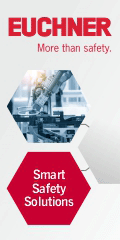
Posted to News on 18th Dec 2013, 10:37
Using energy-efficient electric motors to meet Energy Directives
Legislation on the minimum efficiency levels for AC electric motors has been in force since 2011. These regulations, often known in Europe as the ErP (Energy related Products) Directive, will become increasingly stringent over the next 10 years. The ultimate aim is to reduce the effects of industrial activities on the environment. As electric motors are responsible for 40 per cent of energy use in industrial nations, they are clearly an essential target in the process of reducing our carbon footprint.

The regulations
The European standard IEC60034-30:2008 defines three efficiency classes:
- IE1 standard efficiency
- IE2 high efficiency
- IE3 premium efficiency
More recently IEC60034-31:2010 defined the efficiency levels for a higher motor standard IE4, "super premium'. As an example of the increasing efficiency levels, the minimum efficiency for a 4-pole 7.5kW motor running at rated load are: IE1 85 per cent; IE2 88 per cent; IE3 90.4 per cent; IE4 92.5 per cent.
Regulations are in force across most industrialised countries with similar definitions and efficiency levels. In the USA the EISA (Energy Independence and Security Act) applies. In China they have set the standard GB18613-2006. The European ErP Directive has set the following timescale for the introduction of efficient motors:
- 16 June 2011 - motors must meet the IE2 efficiency level
- 1 January 2015 - motors from 7.5 to 375kW must meet the higher IE3 efficiency level, or must be "equipped' with an inverter variable speed drive
- 1 January 2017 - the 2015 regulations are extended down to motors of 0.75kW
Currently there is no timescale for the introduction of IE4 motors.
Scope and exceptions
The ErP Directive applies to AC asynchronous motors and geared motors in a power range 0.75-375kW. Motors can be 2, 4 or 6 pole, for operation at 50 or 60Hz and rated for continuous operation (S1 or S3). The Directive covers motors that are "placed on the market', that is, manufactured in or imported into the European Union. Effectively this means that all new motors sold must comply if they are within the scope and are to be installed in the EU. End-users are permitted to repair or rewind existing motors.
Current exceptions of brake motors, 8-pole motors and motors designed for extreme temperatures/altitudes are expected to be brought into the scope towards the end of 2013. There will remain a number of other exceptions, such as motors not designed to run at 50/50Hz, explosion proof/ATEX motors and those with a rated voltage above 1000V. However, the vast majority of industrial installations where the power is above 0.55kW will need to comply, either at the IE2 or the IE3 levels.
Drawbacks of higher-efficiency motors and alternative options
Manufacturing a motor with higher efficiently requires designs with more copper content and higher manufacturing precision. This in turn results in higher costs and, in some cases, significant increases in size. Justification of the higher purchase cost is usually straightforward: energy costs can amount to 90 per cent of the lifetime cost for electric motors and a 2-3 per cent saving can result in payback times of less than 2 years. So there is no good argument against the extra cost of high-efficiency electric motors. However, where the dimensions of the higher efficiency motor are bigger (they are often longer and in some cases one frame size bigger) there may be serious problems in upgrading machinery. Fortunately there are options to avoid larger dimensions that do not conflict with the regulations, and are also themselves energy efficient.
The use of a frequency inverter with an IE2 motor instead of an IE3 motor has already been mentioned. This avoids the potentially larger dimensions of the IE3 motor. Where the speed of the machine can be varied in response to demand, this is an excellent option. The ErP regulations are not specific about the way that IE2 motors should be "equipped' with an inverter. However it is clear that they do not need to be a single assembly (terminal box inverter) and can be purchased from different suppliers. Self-certification is likely to apply. A well-known application is fluid flow in pumps and fans. If the speed can be turned down to match low demand, large savings of even up to 80 per cent of energy costs are possible. Speed variation can easily be automated by PID controls in the inverter. Alternatively, where motors have to run at partial loads, Lenze offer software built into the 8400 series of inverters that can save up to 30 per cent of energy used.
Lenze's MF series of motors available from 0.55 to 22kW are rated to run with inverters at a setpoint of 120Hz. As such they fall outside the regulations and can be used without restriction. The higher power delivered at 120Hz leads to motor size reductions of one or even two frame sizes, and the performance comes with good efficiency, actually around the top end of IE2 levels. MF motors are available on their own or with a full range of gearboxes. They represent a good way of keeping small dimensions whilst complying with the ErP regulations.
New for 2014 is the Lenze Smart Motor, another product that is outside the regulations because it is not rated at 50Hz. This new drive available in 63 and 80 frame sizes is a combination of a standard motor with some clever electronics. It is designed for running at fixed speeds that can be adjusted and set using at smartphone app. The Lenze Smart Motor can be set to run at any speed from 500 to 2600r/min. With 400 per cent starting torque available, there is often saving of one frame size and actual running efficiency is high at IE3 levels.
Future introduction of the higher IE4 standard
Looking into the future, it is inevitable that the higher demands of IE4 efficiency levels will become law, although it is unlikely in this decade. To reach these high levels motor manufacturers have to move away from induction motors to permanent magnet, brushless servo and synchronous reluctance technologies. Manufacturing costs will step up sharply and again there will be dimension changes. For powers up to 15kW, efficient synchronous servo motors and geared motors are available now with the Lenze MCS range. Running efficiencies are in a range from 80 up to 94 per cent depending on power.
Whilst the inevitable escalation of electric motor efficiency regulations can be a headache for machine manufacturers, the end user gains with significantly lower lifetime operating costs. In some cases motors with higher efficiency will have larger dimensions. Where this is a problem there are existing systems based on electronic variable speed technology that can minimise motor size whilst also offering higher efficiency.
Please visit www.Lenze.com to learn more about energy-efficient electric motors.
Want the latest machine building news straight to your inbox? Become a MachineBuilding member for free today >>















